High in the sky! Scenic ropeways in Eastern Japan

Japan is blessed with majestic mountains, picturesque seasonal colours, and scenic rivers and lakes. Whether it’s in the floral season of spring, the verdant green season, the fiery-red and golden coloured season of autumn, or the pristine white snowy season of winter, the country has a pure natural beauty that all visitors can enjoy throughout the year.
Getting a perfect shot of the surrounding natural view usually requires one to do so from the air, and one of the best ways to do this is to hop on a ropeway. The ropeway isn’t just a mode of transport to get up a mountain or an observation deck; it also offers visitors the opportunity to soak in the breathtaking panoramic view around them. Not only that, but by riding the ropeway, visitors can also gain access to spectacular scenery that is otherwise not possible by other means, such as Senjojiki Cirque (千畳敷カール Senjōjiki-kāru) and some of the 100 Famous Japanese Mountains (日本百名山 Nihon Hyaku-meizan), a list of scenic mountains compiled by mountaineer Fukada Kyuya (深田久弥). On top of that, ropeways are your ticket to getting superb winter views, where you can see white snow covering an entire landscape.

Selected scenic ropeways in Eastern Japan. (Image credit: JR Times)
Do you know that Eastern Japan is home to many scenic ropeways? From the mountains in the prefecture of Aomori (青森県) to the valleys in the western part of Kanagawa Prefecture (神奈川県), the region has plenty of glorious natural scenery that is best viewed from above, and there’s no better way to do it than from a ropeway. For this article, let’s check out some of the most scenic ones in the region. Hope you’re not afraid of heights!
(Note: the selected ropeways are divided according to their regions: the Tohoku Region (東北地方), the Shinetsu Region (信越地方), and the Kantō Region (関東地方).)
Tohoku Region

Selected scenic ropeways in the Tohoku Region. (Image credit: JR Times)
We begin with the northeastern region of Tohoku, a land filled with mountainous terrain and splendid seasonal colours. It has always been known for its natural beauty, and with many places with high elevations, it also has many scenic ropeways that visitors ought to check out, especially in autumn and winter when the surroundings transform into real-life landscape paintings.
① Hakkoda Ropeway

The seasonal views from the Hakkoda Ropeway during autumn (left) and winter (right). (Image credit: Aomori Prefecture (left), 東北観光推進機構 (right))
First up in Tohoku, we head up to the northernmost prefecture of Aomori where we can find the majestic Hakkoda Mountains (八甲田山系 Hakkōda-sankei). The mountains are located in Towada-Hachimantai National Park, and are recognised as one of the 100 Famous Japanese Mountains. The mountains are known for their astounding beauty especially autumn and winter, and to witness it in full view, one of the best ways is to hop on the Hakkoda Ropeway (八甲田ロープウェイ).
First opened in 1968 and renewed in 2003, the ropeway brings visitors up an ascent of approximately 650m from the mountain base station to the summit station, and the cable car travels for a total length of almost 2.6km. The ride takes around 10 minutes, and during this time, visitors can witness magnificent views during different seasons, such as sprawling summer greenery, fiery-red foliage during autumn, and pure white snow carpeting the landscape. Visitors can also stand to see snow monsters (樹氷 juhyō) on the mountain slopes in winter if the weather is right!
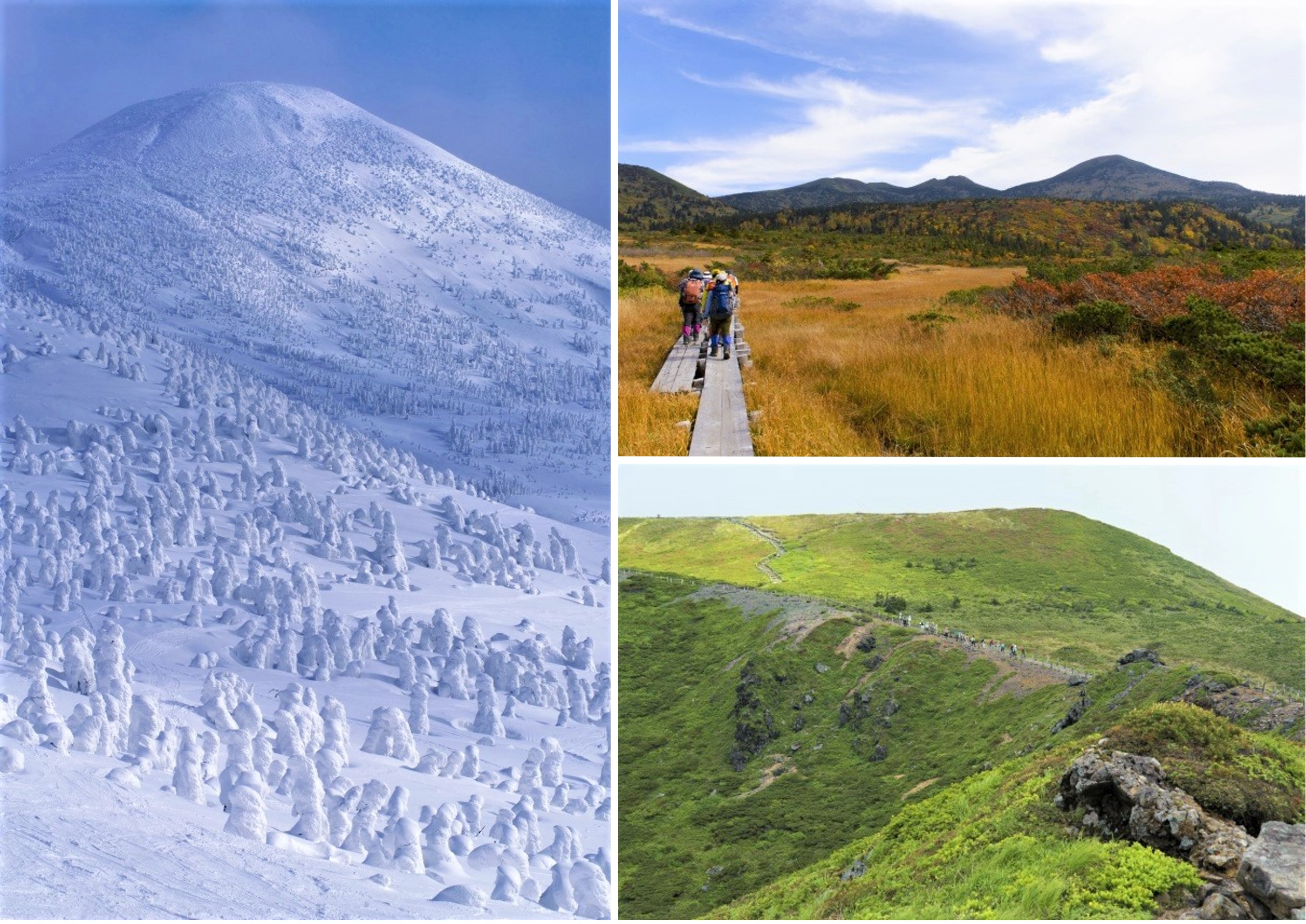
Snow monsters during winter (left) and hiking in autumn (top right) and summer (bottom right). (Image credit: Aomori Prefecture)
Visitors can also take part in exciting activities once they reach the summit station, depending on the time of the year. In summer and autumn, they can take on a hiking trail and explore the surrounding natural splendour such as marshes and alpine flora on foot, or even make their way to Sukayu Onsen (酸ヶ湯温泉). Skiing is also popular here during winter, and what’s more, people can do so for an extended period from mid-November to mid-May (depending on the weather).
Regardless of the season, a ride on the Hakkoda Ropeway is always a treat, and fans of panoramic views should include this one on their list.
Hakkoda Ropeway (八甲田ロープウェー)
Address: Kansuizawa-1-12 Arakawa, Aomori 030-0111
Nearest station: 60-minute (summer) / 80-minute (winter) *bus ride from JR Aomori Station (JR青森駅) to **Hakkoda Ropeway Ekimae (八甲田ロープウェイ駅前) bus stop
Operating hours:
March–Early November: 9am–4:20pm (last ascent)
Mid-November–February: 9am–3:40pm (last ascent)
Admission fees: ¥1,250/adult per one way, ¥2,000/adult per round trip
*Take note that the bus ride is covered by the JR EAST PASS (Tohoku area).
**Depending on the weather conditions, the bus may stop at Sukayu Onsen bus stop instead.
② Mt. Moriyoshi Gondola
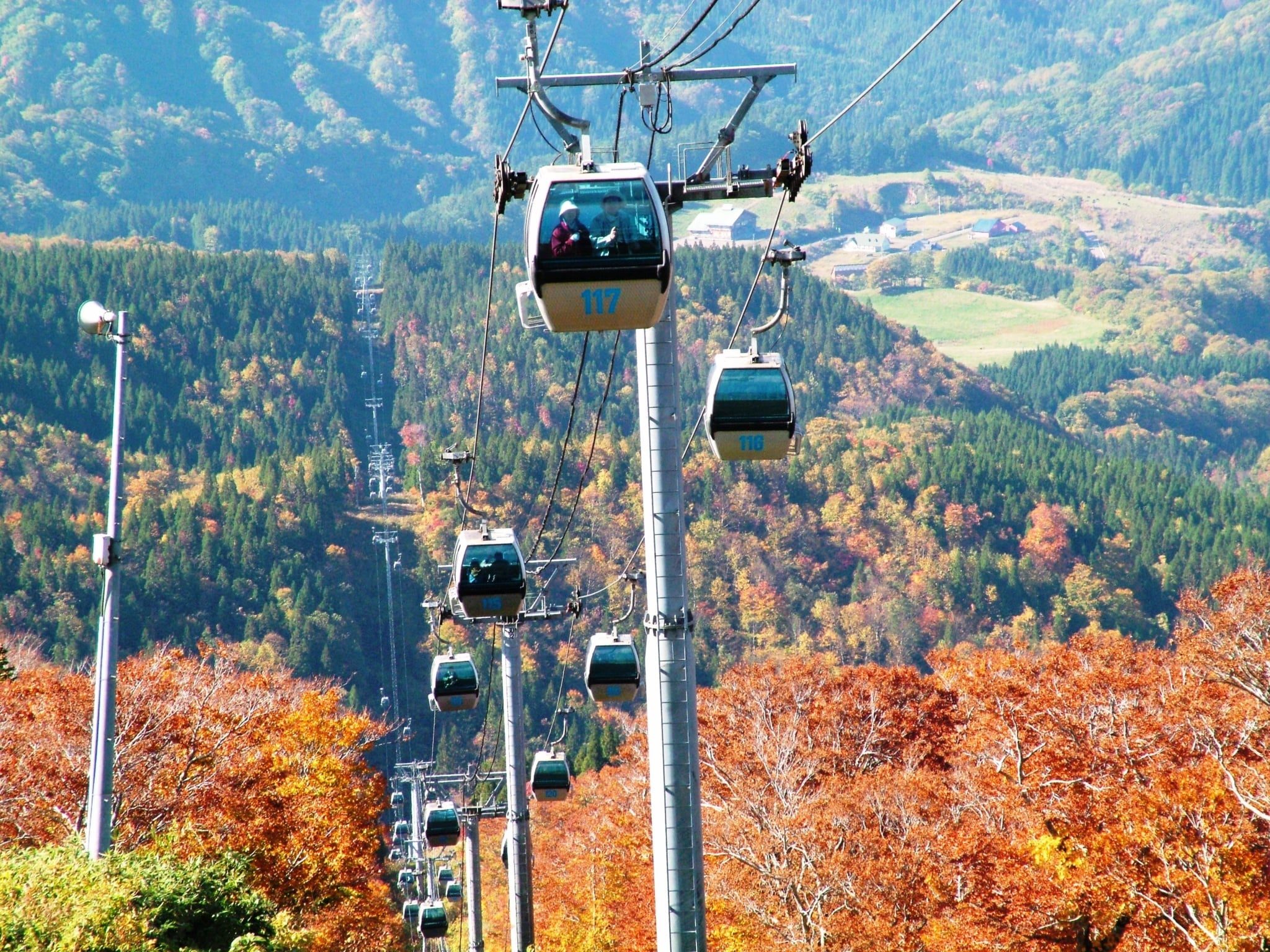
Riding the Mt. Moriyoshi Gondola during autumn. (Image credit: Akita Inu Tourism)
Next, we head over to the prefecture of Akita (秋田県) where we can find Mt. Moriyoshi Gondola (森吉山ゴンドラ). The ropeway enables visitors to ascend Mount Moriyoshi (森吉山 Moriyoshi-zan), and during autumn, visitors will be treated to an amazing view of crimson red foliage before their very eyes while onboard the cable car.
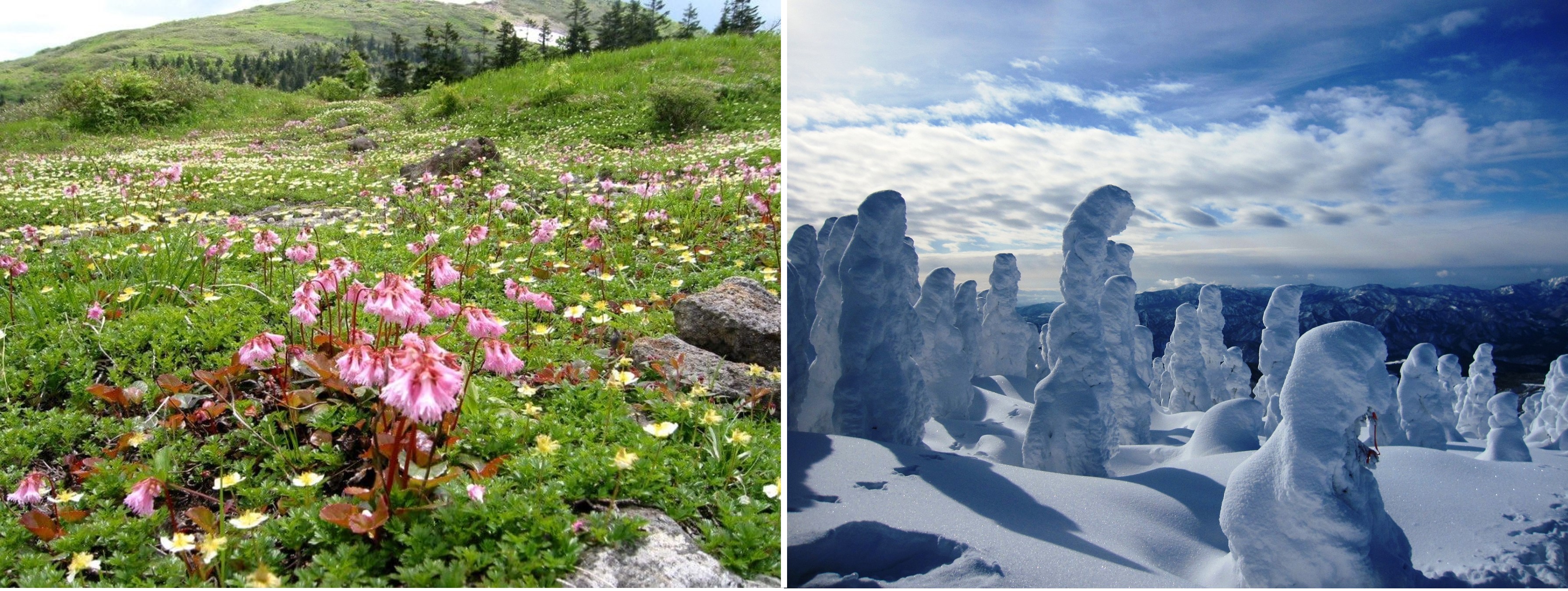
Alpine flowers in the summer (left) and snow monsters during winter (right). (Image credit: Akita Inu Tourism)
Do you know that Mount Moriyoshi is one of Japan’s 100 Famous Flower Mountains (花の百名山 Hana no Hyaku Meizan)? The 1,454m mountain is home to more than 300 alpine flowers, and with many hiking trails to choose from upon arrival at the ropeway’s summit station, it has gained a reputation among nature lovers and hiking enthusiasts. In winter, visitors can take part in snow activities such as winter hiking and skiing, and on top of that, snow monsters can also be seen from early January to early March, from either inside the cable car or even up close (5-minute walk from the summit station)!
Mt. Moriyoshi Gondola (森吉山ゴンドラ)
Address: 79-5 Anikaginotaki, Kitaakita-shi, Akita, 018-4624
Nearest station: 30-minute taxi ride from *Akita Nairiku Jūkan Railway Aniai Station (秋田内陸縦貫鉄道 阿仁合駅)
Operating hours: 8:45am–4pm
Admission fees: ¥1,200/adult per one way, ¥1,800/adult per round trip
*This train ride is not covered by the JR EAST PASS (Tohoku area).
③ Zao Ropeway
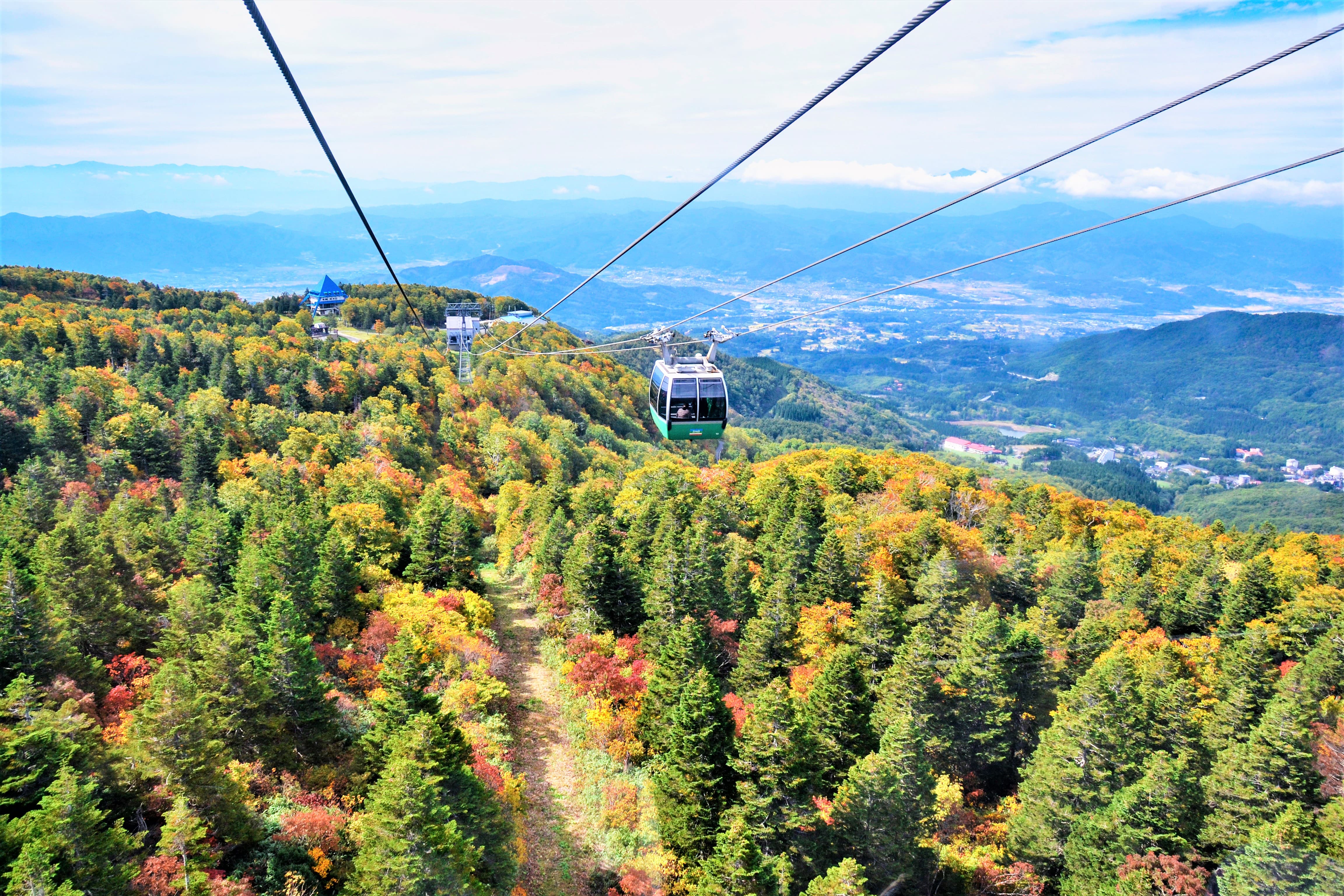
Zao Ropeway’s autumn view. (Image credit: Yamagata Prefecture)
Mount Zao (蔵王山 Zaō-san) is one of the most iconic mountains in the Tohoku Region, and is highly popular among visitors seeking some trekking action especially during the green season, and snow activities during winter. One of the best ways to enjoy the mountain’s seasonal beauty is to hop on the Zao Ropeway (蔵王ロープウェイ), and visitors on the ropeway are in for several surprises.
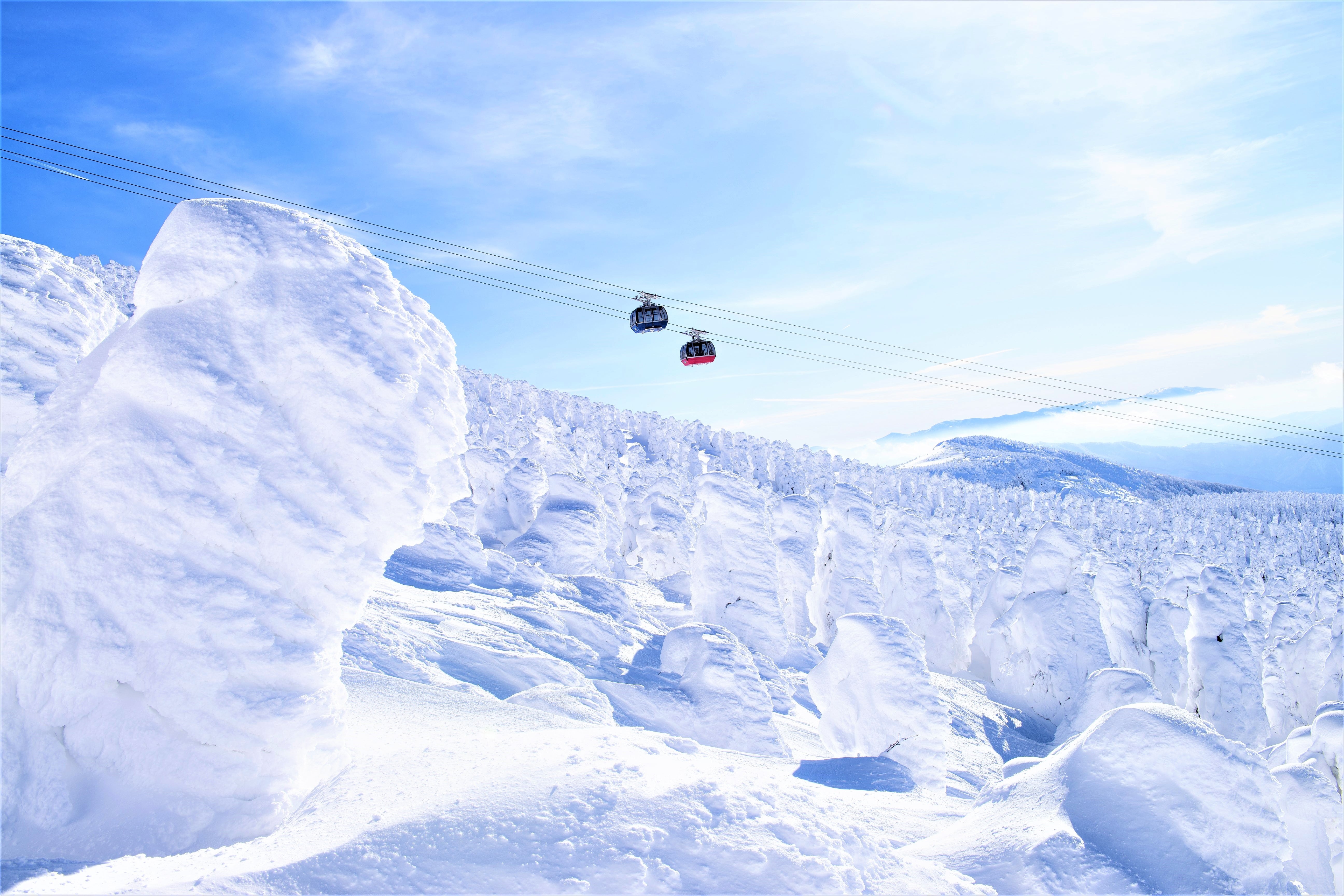
Snow monsters seen from the ropeway during winter. (Image credit: Yamagata Prefecture)
There are two sections on the ropeway altogether: the Sanroku Line (山麓線) that takes visitors from Sanroku Station (山麓駅) at the base of the mountain to Juhyo-Kogen Station (樹氷高原駅), and the Sancho Line (山頂線) that takes them from Juhyo-Kogen Station to Jizo Sancho Station (地蔵山頂駅) near the summit of the mountain.
A ride on the two sections takes up to approximately 17 minutes, and during this time, visitors can gaze at the superb view of the surroundings that change according to the season. Whether it’s the vibrant verdant scenery of the green season, the red and golden hues of autumn, or the plain white snowy landscape of winter, the view onboard the ropeway is something that everyone should see. And of course, if you are paying a visit during winter, don’t miss the famous Zao snow monsters that line the mountain slopes!

Hot spring resorts around Mount Zao. (Image credit: Yamagata Prefecture)
On top of riding Zao Ropeway, be sure to check out all the exciting experiences that await you around the area. Visitors can discover the diverse alpine flora and amazing viewpoints during summer, indulge in the picturesque scenery during autumn, or take part in winter activities such as skiing and snowboarding during the snowy season. There is something for everyone here, which makes Zao Ropeway one of the most popular (and scenic) ropeways on our list.
Zao Ropeway (蔵王ロープウェイ)
Address: 229-3 Zao Onsen, Yamagata-shi, Yamagata 990-2301
Nearest station: 45-minute bus ride from JR Yamagata Station (JR山形駅)
*Operating hours:
1 April–10 December: 8:30am–5pm
11 December–31 March: 8:15am–4:45pm (Sanroku Line), 8:30am–4:30pm (Sancho Line)
Admission fees:
Sanroku Line: ¥1,500/adult per one way, ¥3,000/adult per round trip
Sancho Line: ¥800/adult per one way, ¥1,500/adult per round trip
*Take note that ropeway services may be suspended depending on the weather conditions.
④ Adatarayama Ropeway

View from the Adatarayama Ropeway in the summer. (Image credit: 福島県観光物産交流協会)
Located 15km southwest of the city of Fukushima (福島市) in Fukushima Prefecture (福島県) is Mount Adatara (安達太良山 Adatara-yama), which is a collection of active volcanoes that forms a broad mountain. Chosen as one of Japan’s 100 Famous Japanese Mountains and also one of the 100 Famous Flower Mountains, the 1700m-high mountain’s unique formation makes for a picturesque landscape, and visitors can enjoy it by riding the Adatarayama Ropeway (安達太良山ロープウェイ).
The ropeway is accessible from Adatara Kogen Ski Resort (あだたら高原スキー場), and visitors on the ropeway will ascend 400m to the summit station in less than 10 minutes. Along the way, they can enjoy an aerial view of the city of Nihonmatsu (二本松市), and if the weather is clear, they can see as far as Fukushima and Kōriyama (郡山市). On top of that, visitors can feast their eyes on the amazing colours of the surrounding scenery, from the vivid greenery of the summer to the crimson red and golden hues of autumn.

Mount Adatara’s autumn foliage seen from Yakushidake Panorama Park. (Image credit: 福島県観光物産交流協会)
After a ride on the ropeway, why not explore Mount Adatara’s natural splendour further? A 5-minute walk from the summit station, and visitors will arrive at the Yakushidake Panorama Park (薬師岳パノラマパーク) where they can have a sweeping panoramic view of the surrounding areas. The view from here is much loved by mountaineers and climbing enthusiasts, and in fact, it is made famous by excerpts from “Innocent Story” (あどけない話 Adokenai Hanashi) and “Two People Under a Tree” (樹下の二人 Juka no Futari), taken from an anthology by poet and sculptor Takamura Kōtarō (高村 光太郎) named “Selections of Chieko” (智恵子抄 Chieko-shō):
“The blue sky appearing above Mount Adatara every day is Chieko's true sky.”
"That is Mount Adatara and that gleam vision is the Abukuma River."
Adatarayama Ropeway (安達太良山ロープウェイ)
Address: Okudake Onsen, Nihonmatsu, Fukushima 964-0074
Nearest station: 30-minute taxi ride from JR Nihonmatsu Station (JR二本松駅)
*Operating hours: 8:30am–4:30pm (mid April–late November, last ascent from base station at 3:50pm, last descent from summit station at 4:20pm)
Admission fees: ¥1,050/adult per one way, ¥1,750/adult per round trip
*Ropeway services may be suspended depending on the weather conditions, and does not operate on selected weekdays, so visitors are encouraged to check the official website for the operating schedule.
Shinetsu Region

Selected scenic ropeways in the Shinetsu Region. (Image credit: JR Times)
For our next region, we look at Shinetsu, which is also known for its natural splendour. It is made up of two prefectures: Niigata (新潟県) and Nagano (長野県), with the former directly facing the Sea of Japan (日本海 Nihon-kai), and the latter landlocked by beautiful mountains. The region has a fair share of scenic ropeways, and we shall begin by exploring those in Niigata first.
⑤ Mount Hakkai Ropeway

Winter view from the Mount Hakkai Ropeway. (Image credit: Niigata Prefecture)
Mount Hakkai (八海山 Hakkai-san) is a mountain in Niigata Prefecture that has been worshipped as sacred since ancient times. It is one of the Echigo Sanzan (越後三山 Echigo Three Mountains), along with Mount Echigo-Komagatake (越後駒ヶ岳) and Mount Nakanodake (中ノ岳), and is also renowned for its seasonal natural beauty.
Visitors can ride the Mount Hakkai Ropeway (八海山ロープウェイ) which offers an incredible view of the surrounding areas of Mount Hakkai, such as vivid greenery in the summer or the vibrant foliage of autumn. Operated by Prince Hotels, the ropeway allows visitors to ascend to the summit in 5 minutes, and once there, they can make their way to the Mount Hakkai Observatory (八海山展望台 Hakkai-san tenbōdai) where they can get even more wondrous views.

The seasonal colours of Mount Hakkai. (Image credit: Niigata Prefecture)
When it comes to the sheer seasonal beauty, Mount Hakkai is one of the best places to explore and appreciate Niigata’s four seasons. Especially with a clear blue sky, the vivid colours of the seasons become even more pronounced, and what better way to see them all than from the air while on the ropeway.
Mount Hakkai Ropeway (八海山ロープウェイ)
Address: 1610 Yamaguchi, Minami Uonuma, Niigata 949-7121
Nearest station: 30-minute bus ride from JR Muikamachi Station (JR六日町駅)
Operating hours: 8:15am–5pm
*Admission fees: ¥1,300/adult per one way, ¥2,100/adult per round trip (25 December 2021–21 March 2022)
*Fees are subject to change for the new season.
⑥ Yuzawa Kogen Ropeway

Panoramic view from the Yuzawa Kogen Ropeway. (Image credit: Niigata Prefecture)
Another place in Niigata where visitors can appreciate the splendorous natural views is in Echigo-Yuzawa (越後湯沢), a hot spring town that is often recognised for its ski resorts. It is also home to amazing scenery throughout the seasons, and one of the best ways to capture the views is to hop on a ropeway not far from JR Echigo-Yuzawa Station (JR越後湯沢駅).
The Yuzawa Kogen Ropeway (湯沢高原ロープウェイ) is one of the several ropeways that visitors in Echigo-Yuzawa can ride to go up to higher elevations. Visitors can hop on this one to go up to Yuzawa Kogen Alp no Sato (湯沢高原アルプの里) located at an altitude of 1,000m. With a length of 1,300m, the ropeway offers a spectacular of the town below and the vivid colours of the season all around them. It is also one of the biggest in Japan: each cable car has a total capacity of up to 166 passengers!

Views of summer (left) and autumn (right) around the area. (Image credit: Niigata Prefecture)
After the ride on the ropeway, visitors will arrive at Yuzawa Kogen Alp no Sato where they can take part in various outdoor activities such as trekking, bobsledding, mini-go kart, and ziplining. The park is also surrounded by a plethora of alpine flowers during summer and orange foliage in autumn, so visitors wanting to take things slow can also simply enjoy soaking in the wondrous views of Mother Nature around them.
Yuzawa Kogen Ropeway (湯沢高原ロープウェイ)
Address: 490 Yuzawa-machi, Minami Uonuma, Niigata 949-6101
Nearest station: 5-minute walk from JR Echigo-Yuzawa Station (JR越後湯沢駅)
Operating hours:
Green season (late April–mid-November): 8:40am–5pm (last ascent at 4:40pm)
*Winter season (mid-December–end March): 8:40am–5pm (last ascent at 4:20pm)
Admission fees: ¥2,400/adult per round trip
*18 December–27 March for 2022; operating hours are subject to change for the new season.
⑦ Ryuoo Ropeway

Ryuoo Ropeway during the green season (left) and autumn (right). (Image credit: Ryuoo Ski Park)
Next, we move to the second prefecture in the Shinetsu Region: Nagano (長野県). Famous for its natural charms, the prefecture is often regarded as having some of the most beautiful autumn foliage and winter landscapes in Japan. To enjoy a glimpse of Nagano’s charms, we start with Ryuoo Ropeway (竜王ロープウェイ).
The ropeway is located at Ryuoo Ski Park (竜王スキー場), the largest ski resort in the Kita-Shiga Kōgen (北志賀高原) area. With it, visitors can ascend 790m up the mountain in approximately 8 minutes, and they can marvel at the spectacular scenery around them. During winter, they can see picturesque mountains in the far distance on a clear day, and during the green season, they will be met with lush verdant greenery all around them.

SORA terrace. (Image credit: Ryuoo Ski Park)
Upon reaching the summit station, visitors can also take part in exciting seasonal activities, whether it’s leisure hiking during the summer, or joining other skiers and snowboarders during the winter. But the one place everyone should check out is SORA terrace, a chic café that offers a breathtaking view of the sea of clouds (雲海 unkai) that visitors can see before their eyes. The establishment has an outdoor veranda where they can witness this marvellous view, making them feel like they’re floating right above the clouds!
The sea of clouds can be seen in all four seasons, and the café experienced a 62% chance of seeing it for a given day in 2020. If you would like to see the sea of clouds, your chances are higher in the evening than in the morning and afternoon (30.38%, versus 21.7% and 9.92% respectively according to data from 2020).
Ryuoo Ropeway (竜王ロープウェイ)
Address: 11700 Yomase, Yamanochi, Shimotakai, Nagano 381-0405
Nearest station: 30-minute shuttle bus ride from *Nagano Electric Railway Yudanaka Station (長野電鉄 湯田中駅)
Operating hours: 8am–5pm (5pm–9pm during the special nighttime period from 25 December–3 January, until 8pm for weekdays during this period)
Admission fees: ¥5,000/adult for 1-day pass, ¥4,100/adult for half-day pass
*Rides on railway lines operated by Nagano Electric Railway are not covered by the JR East passes.
⑧ Kita-Yatsugatake Ropeway

Seasonal colours around the ropeway. (Image credit: Kita Yatsugatake Resort)
For our next scenic ropeway in Nagano, we move over to the city of Chino (茅野市). The city is blessed with picture-perfect natural scenery in all four seasons, and one of the highlights is the view of the Japanese Alps (日本アルプス Nihon Arupusu), which visitors can see by hopping on the Kita-Yatsugatake Ropeway (北八ヶ岳ロープウェイ).

The summit station’s observation deck. (Image credit: Kita Yatsugatake Resort)
The ropeway is 1,771m above sea level, and it takes visitors from the base station more than 400m up to the summit station that has an altitude of 2,237m within 7 minutes. Up to 100 visitors can ride the ropeway at a time, and during the ascent, visitors will get a panoramic view of the natural surroundings. Once at the top, they will be greeted with an even more amazing view of the Japan's Three Big Alps (日本三大アルプス Nihon sandai arupusu)—the Northern Alps (北アルプス Kita Arupusu), the Central Alps (中央アルプス Chūō Arupusu), and the Southern Alps (南アルプス Minami Arupusu)—as well as the Yatsugatake Mountains (八ヶ岳連峰 Yatsugatake-renpō), which they can enjoy from the summit station’s observation deck.

Tsuboniwa Natural Park in summer (left) and winter (right). (Image credit: Kita Yatsugatake Resort (left), Chino Tourism Organization (right))
Visitors can also go on to explore the attractions around the area once they arrived at the summit, one of which is Tsuboniwa Natural Park (坪庭自然園 Tsuboniwa shizen-en), a rock garden formed naturally by a volcanic eruption thousands of years ago that resembles a traditional Japanese garden. Hiking is also a popular activity around here during the summer, and in winter, visitors would be in for a surprise as snow monsters can also be seen on the nearby mountain slopes, if the weather conditions are favourable.
Kita-Yatsugatake Ropeway (北八ヶ岳ロープウェイ)
Address: 4035-2541 Kitayama, Chino, Nagano 391-0301
Nearest station: 60-minute bus ride from JR Chino Station (JR茅野駅)
*Operating hours (for 2022):
23 April–16 July: 8:40am–4:40pm (weekdays), 8:20am–5pm (weekends/holidays)
17 July–30 October: 8:40am–4:40pm (weekdays), 8:20am–5pm (weekends/holidays)
31 October–23 November, 17 December–2 April 2023: 9am–4pm
Admission fees: ¥1,200/adult per one way, ¥2,100/adult per round trip
*Operating hours may be subject to change.
⑨ Chuo Alps Komagatake Ropeway

Senjojiki Cirque in the summer (left) and autumn (right). (Image credit: Chuo Alps Kanko (left), photoAC (right))
For our last scenic ropeway in Nagano, we go over to the mountain valleys of the Central Alps (中央アルプス Chuō Arupusu), where we can find the Chuo Alps Komagatake Ropeway (中央アルプス駒ヶ岳ロープウェイ). It is situated at Senjojiki Cirque, which is renowned for its amazing scenery of alpine flowers in the summer and snowy views in winter, and visitors can embark from Shirabidaira Station (しらび平駅) at the base to go up to Senjōjiki Station (千畳敷駅) at the summit. The ascent has an elevation gain of 950m, making it the highest in Japan, and moreover, Senjōjiki Station sits at an altitude of 2,611.5m, making it the highest ropeway station in the country too!

Riding the ropeway in autumn (left) and winter (right). (Image credit: Chuo Alps Kanko)
The ropeway ride takes around 7.5 minutes, and during this time, visitors will be enthralled by the spectacular view around them. In particular, the foliage in autumn is regarded to be magnificent with its vibrant golden and fiery-red hues, and the powdery white snow in winter is a feast for the eyes.
If you’re up for some adventure during summer, you can also consider following a relaxing and enriching hiking course that begins near Senjōjiki Station. For a bigger challenge, take on the Mount Kiso-Komagatake Trail, a half-day mountain climbing route that leads all the way up to Mount Kiso-Komagatake (木曽駒ヶ岳). Be sure to bring all the proper clothing and equipment if you decide to do so.
Chuo Alps Komagatake Ropeway (中央アルプス駒ヶ岳ロープウェイ)
Address: 4749-1, Miyada, Kamiina, Nagano 399-4301
Nearest station: 45-minute bus ride from *JR Komagane Station (JR駒ヶ根駅)
**Operating hours:
10 April–29 November: 8am–5pm
4 December–4 April: 9am–4pm
Admission fees: ¥1,370/adult per one way, ¥2,540/adult per round trip
*This railway station is not covered by the JR East passes.
**Ropeway may be closed on selected days for maintenance, so visitors are encouraged to check the official website for the operating schedule.
Kanto Region

Selected scenic ropeways in the Kanto Region. (Image credit: JR Times)
And lastly, we move to the region of Kantō, which includes Tōkyō (東京) and its surroundings. The region is made up of seven prefectures altogether, and has many mountainous terrains that are pleasantly scenic throughout the seasons. Let’s check out where we can find ropeways with amazing views around here!
⑩ Nasu Ropeway

View of the summer greenery around the Nasu Ropeway. (Image credit: 関東自動車)
Tochigi Prefecture (栃木県) is often recognised as one of Japan’s cultural epicentres, as it is home to the historical city of Nikkō (日光市). But do you know that the prefecture has plenty of natural scenery that can be enjoyed throughout the year? Mount Nasu (那須岳 Nasu-dake), also known as Mount Chausu (茶臼岳 Chausu-dake), is one such example, and is very popular among trekkers and mountain climbing enthusiasts especially in the summer and autumn.

Autumn (left) and winter (right) views around Nasu Ropeway. (Image credit: 関東自動車)
Visitors can go up the mountain by riding the Nasu Ropeway (那須ロープウェイ). Operated by Kanto Transportation, the ropeway offers visitors a sweeping view of the undulating mountain slopes around them and the plains of Nasunogahara (那須野が原). In addition, they will be able to enjoy splendid views of spring flowers, red and yellow maple leaves in the autumn, and pristine white snow during winter.

Sea of clouds from the summit station. (Image credit: 関東自動車)
Furthermore, if the weather conditions are right, visitors can also see a sea of clouds from the summit station, which is always a breathtaking experience that never fails to amaze those who get to see it. Imagine what it feels like to witness clouds beneath you; it’s something you just have to see to believe.
Nasu Ropeway (那須ロープウェイ)
Address: 215 Mount Nasu, Yumoto, Nasu, Nasu, Tochigi 325-0301
Nearest station: 60-minute bus ride from JR Kuroiso Station (JR黒磯駅)
*Operating hours: 8:30am–4:30pm (last ascent / descent: 4pm / 4:20pm)
Admission fees: ¥1,200/adult per one way, ¥1,800/adult per round trip
*Operating hours are subject to change for 2022, and operation may be suspended depending on the weather conditions.
⑪ Tanigawadake Ropeway

Autumn view from the Tanigawadake Ropeway. (Image credit: photoAC)
The landlocked prefecture of Gunma (群馬県) is known for its mountains and valleys, making it one of the most naturally scenic regions in Japan. One scenic mountain is Mount Tanigawa (谷川岳 Tanigawa-dake), which is located on the border of prefectures Gunma and Niigata, and is also one of the 100 Famous Japanese Mountains. To enjoy the mountain’s sheer beauty, one can have a view from the sky by riding the Tanigawadake Ropeway (谷川岳ロープウェイ).

Tanigawadake Ropeway during the summer. (Image credit: photoAC)
The ropeway enables visitors to ascend Mount Tanigawa to reach Tanigawadake Tenjindaira Ski Resort (谷川岳天神平スキー場), a popular ski resort in the region that attracts many winter sports enthusiasts during the snowy season. During the ascent, visitors can get a wondrous view of the surrounding mountain range, and appreciate the vivid colours of the four seasons. On a clear day, they can even get to see Mount Hotaka (穂高岳 Hotaka-dake) and Mount Akagi (赤城山 Akagi-yama). Visitors who would like to have a more intimate experience with the surrounding nature can opt for hiking especially during the hiking season between July and November.

The ridges of Mount Tanigawa in autumn. (Image credit: photoAC)
Here’s an interesting fact: the ropeway’s base station can be accessed on foot from JR Doai Station (JR土合駅), which is also known as “mole station” (モグラ駅 mogura-eki) because of its unusual platform layout where one is 70m underground! If you’re planning to visit the ropeway, be sure to check out this fascinating railway station too.
Tanigawadake Ropeway (谷川岳ロープウェイ)
Address: Yubiso, Minakami, Tone, Gunma 379-1728
Nearest station: 15-minute walk from JR Doai Station (JR土合駅)
Operating hours:
April–November: 8am–5pm (weekdays), 7am–5pm (weekends and national holidays)
December–March: 8:30am–4:30pm (weekdays), 7am–4:30pm (weekends and national holidays)
Admission fees: ¥1,250/adult per one way, ¥2,100/adult per round trip
⑫ Hakone Ropeway

Hakone Ropeway with Mount Fuji in the background. (Image credit: photoAC)
Mention Hakone (箱根), and most people would conjure up images of hot springs and the iconic Mount Fuji (富士山 Fuji-san). Located in the western part of Kanagawa Prefecture, it is one of the most popular tourist destinations in Japan, and given its relatively close distance to Tōkyō and convenient access, visitors find it all the easier to visit the town for a short getaway.
Hakone Ropeway (箱根ロープウェイ) is highly popular among visitors to Hakone as it offers a panoramic view of the surrounding areas from high in the sky. The ropeway is also one of the best ways to enjoy the town’s beauty for all the seasons, from the floral splendour of spring to the golden hues of autumn. But perhaps most importantly, if the weather is favourable, visitors on the ropeway will get a superb view of Mount Fuji from inside the cable car.

Seasonal views around the Hakone Ropeway. (Image credit: Hakone Ropeway Co.,Ltd.)
After a ride on the Hakone Ropeway, why not explore the surrounding areas too? Hakone is filled with natural attractions that visitors shouldn’t miss, such as the sulphuric hot springs of Ōwakudani (大涌谷) and the picturesque calm waters of Lake Ashinoko (芦ノ湖), making it a haven for nature lovers and fans of natural scenery.
The ropeway has four stations altogether—Tōgendai Station (桃源台駅), Ubako Station (姥子駅), Ōwakudani Station (大涌谷駅), and Sōunzan Station (早雲山駅)—and the ride between each station is approximately 8 minutes.
Hakone Ropeway (箱根ロープウェイ)
Address: 164-17 Motohakone, Hakone, Ashigarashimo, Kanagawa 250-0522
Nearest station: 35-minute bus ride from *JR Gotemba Station (JR御殿場駅)
**Operating hours:
1 February–30 November: 9am–5pm
1 December–31 January: 9am–4:15pm
Admission fees: ¥950–¥1,550/adult per one way, ¥1,700–¥2,800/adult per round trip
*This railway station is not covered by the JR East passes.
**Due to the ongoing coronavirus pandemic, the current operating hours will be 9am–4:15pm until 26 March 2022.
Closing
A region blessed with sweeping mountain sceneries and the stunning beauty of the four seasons, Eastern Japan continues to amaze visitors time and time again. Ropeways are one of the best ways for capturing a wide-open view of the region’s natural charms, and they are not simply a means to bring people from one station to another. Being on a ropeway high in the sky with an unobstructed view of vivid seasonal colours around makes for an unforgettable experience, and visitors ought to enjoy every minute of their time as they make their way up to the summit station.
The next time you get to hop on one of the many ropeways in the region, be sure to keep your eyes open and relish every moment of gazing at the spectacular view around you!
JR EAST PASS (Tohoku area)
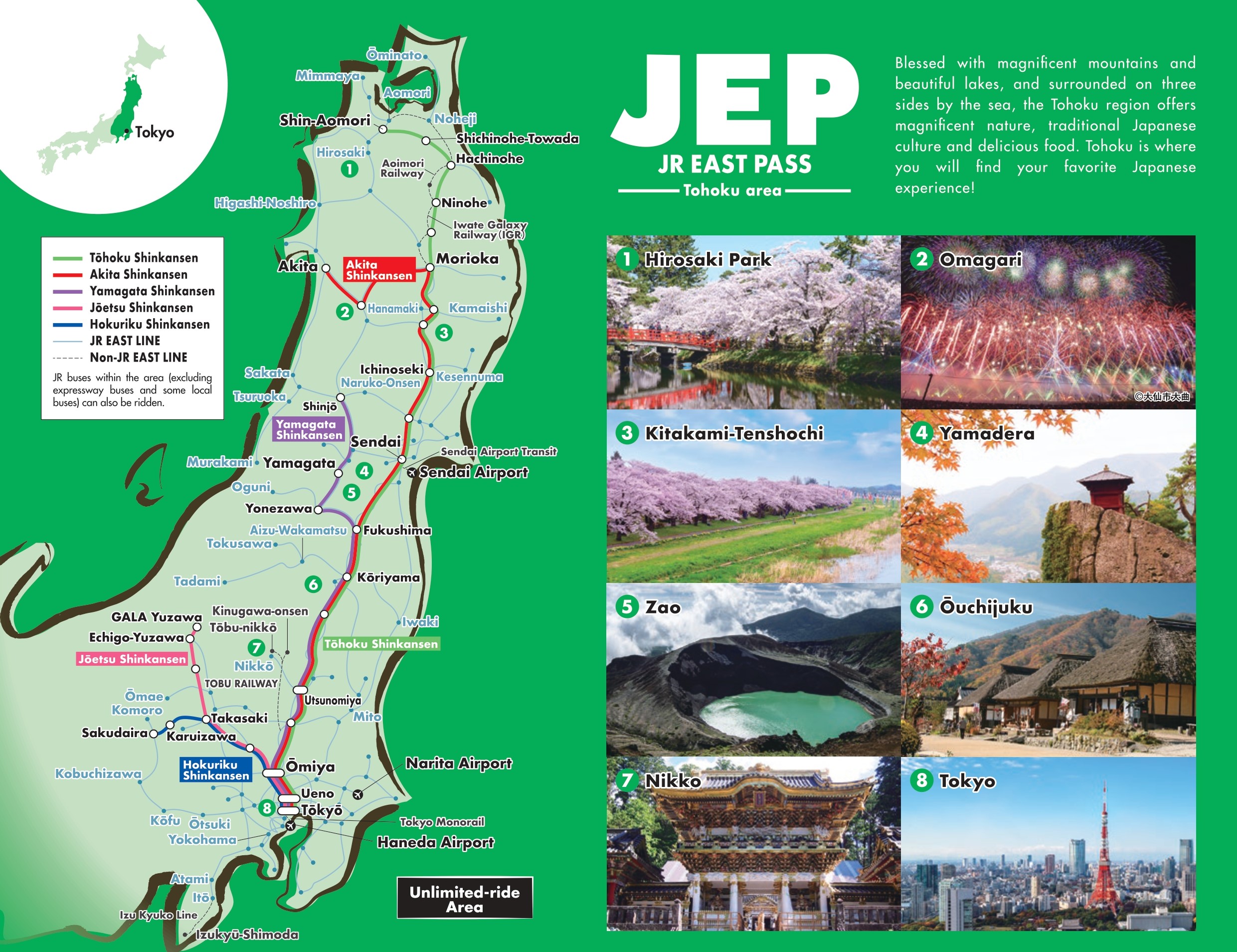
The JR EAST PASS (Tohoku area) and where you can use it. (Image credit: JR East)
If you would like to visit the ropeways above in the Tohoku Region, check out the JR EAST PASS (Tohoku area), an affordable pass that offers unlimited rail travel on JR East lines (including bullet trains) in the valid area for 5 consecutive days. At only ¥30,000, it makes for a great option for railway travellers. The JR EAST PASS (Tohoku area) can be used for automatic ticket gates, and foreign passport holders living in Japan are also eligible to use this pass.
JR EAST PASS (Nagano, Niigata area)

The JR EAST PASS (Nagano, Niigata area) and where you can use it. (Image credit: JR East)
If you’re planning to travel around the Shinetsu Region, check out the JR EAST PASS (Nagano, Niigata area), which offers unlimited rail travel on JR East lines (including bullet trains) in the valid area for 5 consecutive days. At only ¥27,000, it makes for a great option for railway travellers. The JR EAST PASS (Nagano, Niigata area) can be used for automatic ticket gates, and foreign passport holders living in Japan are also eligible to use this pass.
Pass holders can also reserve their seats for free up to 1 month in advance on the JR-EAST Train Reservation.

The JR-EAST Train Reservation. (Image credit: JR East)
Header image credit: (Clockwise from top left) Aomori Prefecture, Yamagata Prefecture, Chuo Alps Kanko, photoAC




